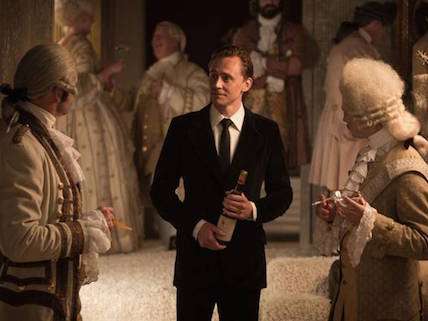Movie Review: High-Rise
Tom Hiddleston meets the new barbarians.


J.G. Ballard's 1975 novel High-Rise is a grim exercise in deadpan dystopian fantasy, and director Ben Wheatley's new movie is an ambitious attempt to bring it to life on the screen. The cast is certainly game—especially Tom Hiddleston, who's supported by Sienna Miller, Jeremy Irons, and a feral Luke Evans. But Ballard's story is so schematic that it starves us of surprise: we can see where it's going, and we're even shown where it will ultimately end, right at the beginning. The picture is all incident—this happens, that happens, more things happen. It's chilly and cruel and increasingly, over the course of two long hours, monotonous.
The titular apartment building is a 40-story tower of Brutalist concrete set amid bleak parking plazas somewhere outside of London (presumably—it could be any soul-dead modern metropolis). Dr. Robert Laing (Hiddleston) was drawn here by the building's promise of self-contained contentment: there's a squash court, a vast swimming pool, a full-floor supermarket. But now the place is falling apart. There are frequent power blackouts, and the elevators are iffy, the halls are strewn with trash, and the supermarket fruit is rotting on the shelves. Unsurprisingly, the residents are, at first metaphorically and before long literally, at each other's throats.
The movie is an anti-capitalist cartoon. The lower floors of the high-rise are inhabited by angry proles: chirpy flight attendants, low-level film technicians—people pathetically willing to over-pay for a shot at the luxe life. The middle floors, where Laing lives, entombed in an apartment of fluted concrete and shag carpeting, are reserved for the professional classes: doctors, lawyers, prosperous accountants. Up on the top floors are the vicious rich—tycoons, entrepreneurs, glittery TV stars. It's a "nightmare termitary," as Ballard put it, a place where the residents "thrived like an advanced species of machine."
In a penthouse at the very top of the building lives its designer, an architect with the believe-it-or-not name of Anthony Royal (Irons). Here, amid broad lawns and gardens, Royal and his fellow economic oppressors entertain themselves at lavish costume parties that recall the decadent pleasures of pre-revolutionary Versailles, just before the hammer came down.
Far down below, where he lives with his pregnant wife (Elisabeth Moss) and two kids, a burly wild man named Wilder (Evans) is seething. He blames the building's deterioration—the clogged trash chutes, the rarely available elevators—on the snotty swells up above. When his kids are turned away from the big pool, he determines to fight his way to the top and set things right.
Through all of this, Laing (his name seems like a possible nod to the controversial Scottish psychiatrist R.D. Laing, although for reasons unclear) remains a man of little agency. He engages in some sexual sport with an upstairs neighbor named Charlotte (Miller), but otherwise wanders through the mounting chaos—dog murders, beatings, balcony leaps—in a haze of indifference. Laing continues going to work as an instructor at a nearby medical school (there's a wonderfully grisly shot of him peeling the bloated flesh off a lifeless skull). But slowly he stops—he finds he can't tear himself away from the garish horrors at the deteriorating high-rise.
Why do none of the abused residents of this building simply choose to move out? And what about the law? (A few policemen appear at one point, but they're easily rebuffed.) Obviously, we're meant to think that plutocrats run everything in this world—but how exactly does that work? Ballard was not a man for political particulars; his concern was with technological alienation. And the movie's faithful script, by Amy Jump, attempts no answers either. High-Rise recalls the simplistic social symbolism of Bong Joon-ho's Snowpiercer—it's Class Warfare 101. Which is not going to be everybody's idea of a great movie.



Show Comments (58)